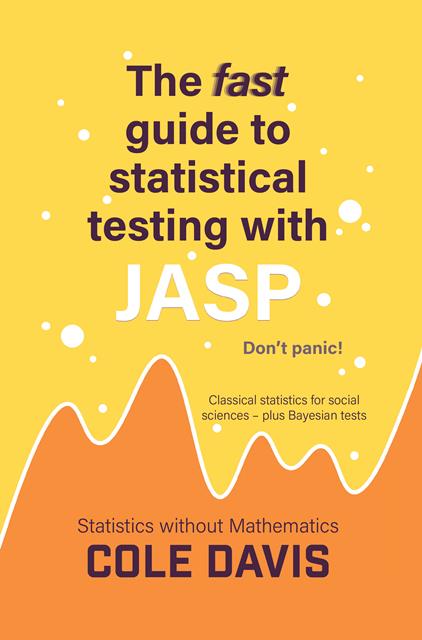|
| Home |
| Order books |

|
The fast guide to statistical testing with JASP
The fast guide to statistical testing with JASP
Exercises and case studies
Chapter 9 in the book contains basic exercises covering the preceding three chapters. Diverse tutors, however, have asked for traditional chapter by chapter exercises, hence the table immediately below. Further down the page, case studies are presented for readers who have finished reading the whole book, or their tutors.Exercises
These chapter by chapter exercises have been contributed by Marianne Vitug. For each chapter is a document with the questions, and one with the answers, with relevant spreadsheet files (with the .csv suffix). Each page opens in a new tab of your browser.
| Ch 2 Research design | Questions | Answer | self-entry |
| Ch 3 Descriptive statistics | Questions | Answers | data file HW |
| Ch 4 Null hypothesis significance testing | Questions | Answers | data file HW |
| Ch 5 Bayesian statistics | Questions | Answers | data file 0 |
| Ch 6 Tests of differences | Questions | Answers | data file 1 |
| Ch 6 Tests of differences | data file 2 | ||
| Ch 6 Tests of differences | data file 3 | ||
| Ch 6 Tests of differences | data file 4 | ||
| Ch 7 Tests of relationships | Questions | Answers | data file |
| Ch 8 Categorical analyses | Questions | Answers | data file |
| Ch 11 Factorial ANOVA | Questions | Answers | data file 1 |
| Ch 11 Factorial ANOVA | data file 2 | ||
| Ch 11 Factorial ANOVA | data file 3 |
Case studies
You have a theory that participants in riots tend to listen to social media for news,
while non-participants are less likely to rely on social media for information.
You believe that age, ethnicity and gender may also affect the classification.
You have a large database comprising measures of health and wellbeing for older people.
Your interest is in investigating different forms of social capital.
Are certain social attitudes characteristic of different religious groups?
Age, ethnicity and gender may also affect the classification.
You are interested in studying people who find work as expats.
How far do people go? Differentiating between those who travel to countries just beyond the border,
countries at the other end of the earth and those in between,
you may wish to consider class, educational levels and age
as well as other demographics.
Do different forms of post-prison rehabilitation have an effect on re-offending, finding work and family functioning?
You are interested in the effects of caste reforms in India, particularly in its effects on long-term unemployment.
How would you contrast different castes, or areas with different ways of doing things?
We are interested in longevity among Russian males. What might be the simplest way of examining this?
Are schoolchildren in ability groupings more likely to perform academically than those in mixed ability groupings.
Does gender have a part to play?
Each year, over three years, a different policing stance is used with local youths.
Each method is used in three different types of community setting.
By the end of the period, each setting would have experienced all of the methods.
Does marrying younger affect the length of a marriage? Are second marriages happier?
Do men and women have comparable perceptions?
Are there particular categories of people who believe in conspiracy theories?
(Assume that there is no knowledge of the topic.)
Statistics without Mathematics series - General Editor: Cole Davis
ISBN numbers: Hardback - 978-1-915500-24-3 Paperback - 978-1-915500-25-0
Ebook - 978-1-915500-26-7
